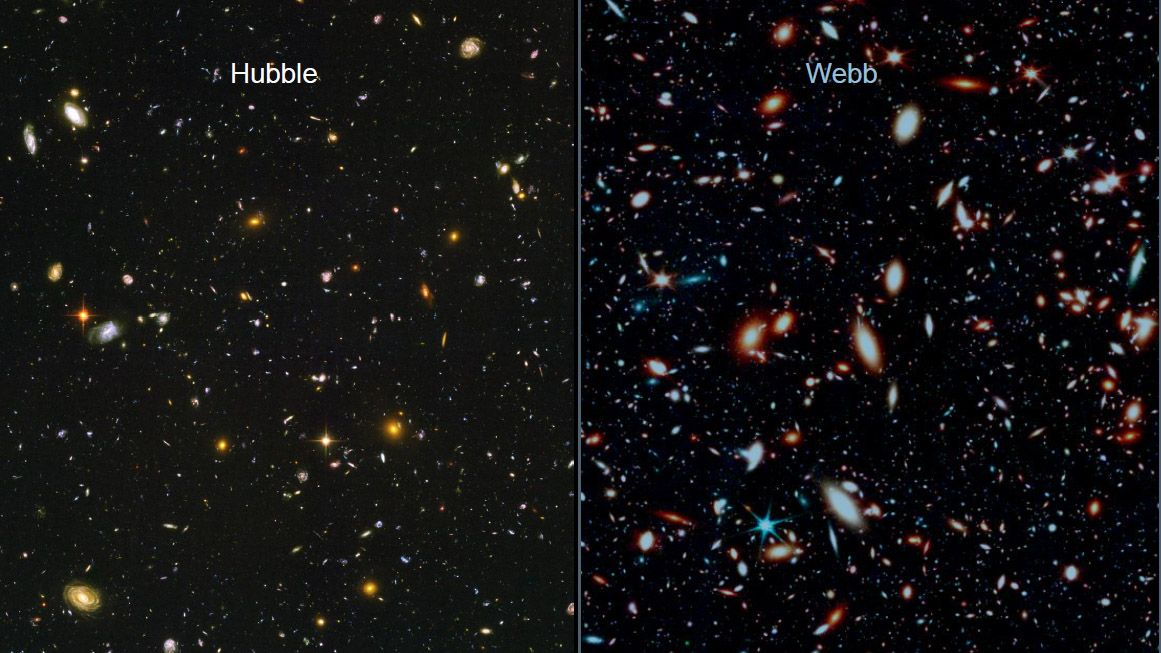Oldest Galaxies in the Universe Discovered by Webb Telescope
The James Webb Telescope is the most sophisticated space telescope in history, designed to study the earliest galaxies and stars that formed after the Big Bang. Recently, astronomers have announced the discovery of some of the oldest galaxies in the universe using this space telescope.
The astronomers published two studies in Nature Astronomy journal, announcing their discovery of the four farthest galaxies ever detected.
The galaxies in question are some of the earliest to form after the Big Bang. They are in a region of space called the Hubble Ultra Deep Field.
Scientists have observed this area with the Hubble Space Telescope for over 200 hours, revealing the faintest and most distant galaxies ever seen.
The Power of the James Webb Telescope
The James Webb Space Telescope has now taken a closer look at this area, revealing more detail and providing new insights into the universe’s formation.
NASA's James Webb Space Telescope discovers the four most distant galaxies ever observed, one of which formed just 320M years ago, new research says https://t.co/DnzkfWPnjF
— TRT World (@trtworld) April 4, 2023
Experts believe the James Webb Space Telescope discovered some of the universe’s oldest galaxies, with estimates placing their age at around 13 billion years old.
By studying these galaxies, astronomers hope to learn more about how the first stars and galaxies formed. They also expect to discover how the universe evolved. One key feature of the James Webb Space Telescope is its ability to detect infrared light.
This is particularly useful for studying the earliest galaxies in the universe. The light from these galaxies has stretched and shifted toward the red end of the spectrum by the universe’s expansion.
You may also like: NASA Hubble Telescope Shows What’s Left After Stars Die
This means their light is now in the infrared part of the spectrum. Thus, making it difficult to detect with traditional telescopes. The James Webb Space Telescope can overcome this problem, allowing astronomers to study these ancient galaxies in unprecedented detail.

Photo credit: ESA | NASA | STSCI
With its exceptional capacity to identify infrared light, the Webb telescope’s NIRCam instrument can rapidly identify various galaxies that have never been observed before.
An Ancient Era of the Galaxies
These galaxies date back 300 to 500 million years after the Big Bang. It occurred over 13 billion years ago when the universe was only two percent of its current age.
They belong to the reionization era. It is a period immediately after the cosmic dark ages caused by the Big Bang when scientists believe the first stars appeared.
According to Stephane Charlot, a co-author of the two studies and a researcher at the Astrophysics Institute of Paris, JADES-GS-z13-0 is the farthest galaxy ever observed by astronomers. They believe this galaxy formed 320 million years after the Big Bang.
The Webb telescope confirmed the existence of JADES-GS-z10-0. The Hubble Space Telescope first identified the galaxy. Experts date JADES-GS-z10-0 to be from 450 million years after the Big Bang.
Webb Telescope Discovers Oldest Galaxies Ever Observed https://t.co/ovrOLarmU3 pic.twitter.com/YUHp332wc9
— NDTV News feed (@ndtvfeed) April 4, 2023
Despite being very low in mass, with a weight of roughly a hundred million solar masses, these galaxies are more active in star formation than their mass.
The stars formed at speeds similar to the Milky Way. This surprised experts, given the early time of the universe. Charlot also noted that these galaxies were very poor in metals.
What This Means for Us
The discovery of six massive galaxies from 500 to 700 million years after the Big Bang prompted some astronomers to question the validity of the standard model. These galaxies were more extensive than expected early in the universe’s history.
If they confirm their findings, it could require an update to the standard model. Experts have confirmed four newly discovered distant galaxies, which astronomer Pieter van Dokkum praised as a “technical tour de force.”
According to van Dokkum, the frontier of our understanding of the universe constantly shifts. He asserts there are only 300 million years of new history between these galaxies and the Big Bang.
You may also like: NASA’s Innovative Space Cup Can Hold a Drink in Zero Gravity
While the Webb telescope has observed potential galaxies closer to the Big Bang, their existence remains unconfirmed. The discovery of these ancient galaxies is just the start of what promises to be an exciting new era in astronomy.
The James Webb Space Telescope might reveal many more secrets about the universe. Astronomers and scientists now better understand the formation of stars and planets. They have better knowledge of the distribution of dark matter and the nature of dark energy.
It will also help answer some of the most fundamental questions about human existence, life on Earth came to be, and whether we are alone in the universe.

